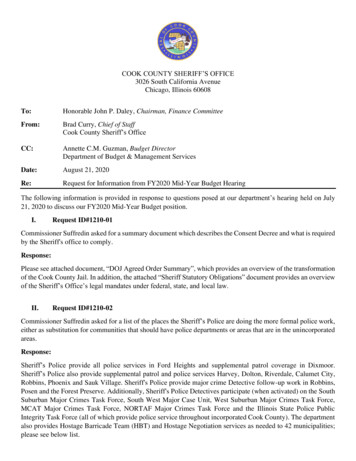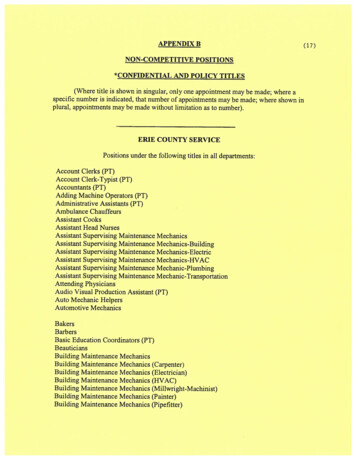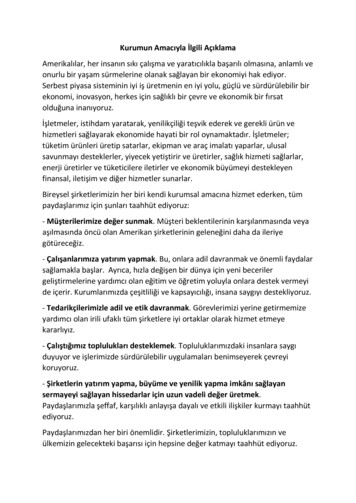
Transcription
COOK COUNTY SHERIFF’S OFFICE3026 South California AvenueChicago, Illinois 60608To:Honorable John P. Daley, Chairman, Finance CommitteeFrom:Brad Curry, Chief of StaffCook County Sheriff’s OfficeCC:Annette C.M. Guzman, Budget DirectorDepartment of Budget & Management ServicesDate:August 21, 2020Re:Request for Information from FY2020 Mid-Year Budget HearingThe following information is provided in response to questions posed at our department’s hearing held on July21, 2020 to discuss our FY2020 Mid-Year Budget position.I.Request ID#1210-01Commissioner Suffredin asked for a summary document which describes the Consent Decree and what is requiredby the Sheriff's office to comply.Response:Please see attached document, “DOJ Agreed Order Summary”, which provides an overview of the transformationof the Cook County Jail. In addition, the attached “Sheriff Statutory Obligations” document provides an overviewof the Sheriff’s Office’s legal mandates under federal, state, and local law.II.Request ID#1210-02Commissioner Suffredin asked for a list of the places the Sheriff’s Police are doing the more formal police work,either as substitution for communities that should have police departments or areas that are in the unincorporatedareas.Response:Sheriff’s Police provide all police services in Ford Heights and supplemental patrol coverage in Dixmoor.Sheriff’s Police also provide supplemental patrol and police services Harvey, Dolton, Riverdale, Calumet City,Robbins, Phoenix and Sauk Village. Sheriff's Police provide major crime Detective follow-up work in Robbins,Posen and the Forest Preserve. Additionally, Sheriff's Police Detectives participate (when activated) on the SouthSuburban Major Crimes Task Force, South West Major Case Unit, West Suburban Major Crimes Task Force,MCAT Major Crimes Task Force, NORTAF Major Crimes Task Force and the Illinois State Police PublicIntegrity Task Force (all of which provide police service throughout incorporated Cook County). The departmentalso provides Hostage Barricade Team (HBT) and Hostage Negotiation services as needed to 42 municipalities;please see below list.
Additionally, Sheriff’s Police operates two 9-1-1 service and radio dispatching centers. The primary location isin Des Plaines, Illinois and the secondary location is in Maywood, Illinois. The 9-1-1 Center operates 22 radiotowers throughout Cook County while providing radio interoperability services to over 95 police agencies inCook County. The 9-1-1 Center also provides CAD (computer aided dispatch) and 9-1-1 service to the entireSheriff's Office (Courts, Corrections, Police) and all of unincorporated Cook County, as well as Berkeley, BlueIsland, Hometown, Indian Head Park, Lyons, Merrionette Park, Palos Park, Park Ridge, Phoenix, Metra Police,the State’s Attorney’s Office, and Forest Preserve Police.BellwoodBerkeleyBroadviewBrookfieldCalumet CityCalumet ParkCiceroCrestwoodDixmoorElmwood ParkFord HeightsForest dian Head ParkLagrangeLagrange ParkIII.CCSPD HBT ServicesLyonsMaywoodMcCookMelrose ParkMerrionette ParkOak LawnOak ParkOlympia FieldsOrland HillsPalos HeightsPalos HillsPhoenixRiver ForestRiver GroveRobbinsSouth Chicago HeightsStegerStickneyStone ParkSummitWestchesterRequest ID#1210-03Commissioner Suffredin asked for a list of the specialty services that the Sheriff provides to suburbanmunicipalities.Response:Please see attached document, “Police Services July 2020”, which provides an overview of the specialty servicesprovided by the Sheriff’s Police.IV.Request ID#1210-04Commissioner Anaya asked for a current inventory list of the Sheriff’s PPE supply.Response:As of August 20, 2020, at 3:30 p.m., the Sheriff’s Office has the following PPE on hand: N95 respirators: 183,007
Face shields: 7,339Surgical masks: 970,536Protective gowns: 130,397Coveralls: 793Gloves: 716,294V.Request ID#1210-05Commissioner Sims asked for the value the Sheriff’s Office has spent to date, in the FY2020 budget, on mentalhealth services.Response:The Sheriff’s Office spends approximately 4 million annually on mental health programming. Cermak HealthServices is the medical and mental health provider for all detainees incarcerated at the DOC. Cermak’s mentalhealth services consist of assessment, screening, individual and group therapy, and psychiatric services includingmedication management. The Sheriff’s Office provides supplemental programming and support to detainees. TheSheriff’s Office mental health services focus on behavioral health interventions, such as group and individualcounseling as well as case management, referrals to specialty courts and resources for individuals at bond court,and discharge services. Cermak utilizes a medical model of mental health services, which is different and separatefrom the behavioral health services offered through Sheriff’s Office programming.VI.Request ID#1210-06Commissioner Sims asked for the number of detainees that require mental health services.Response:In February, prior to the pandemic, there were approximately 500 detainees enrolled in DOC programs that offermental health services. In that same month, Cermak had an average of 1,758 P2 detainees (outpatient mentalhealth), 789 P3 detainees (intermediate mental health), and 79 P4 detainees (infirmary mental health) on theirmental health caseload. Many of the detainees receiving DOC programming were not on Cermak’s mental healthcase load or were designated P2, with minimal services provided by Cermak.VII.Request ID#1210-07Commissioner Silvestri asked how the Sheriff’s Office defines social services and mental health services andwhat the cost is to provide these.Response:Social services are offered through correctional rehabilitation workers (CRWs) or community volunteers. Socialservices encompass a broad range of services to help people in custody with their unique needs. An example ofsome of the “social services” provided include receiving and responding to detainee request slips, managing thedetainee grievance system, coordinating access to services post-release such as coordinating phone interviewswith treatment providers, providing information on obtaining a state ID, facilitating voting in the DOC, providinginformation on housing, food pantries, etc. The DOC employs CRWs, Re-Entry Care Coordinators and volunteercoordinators to manage community groups that come to the jail to offer social services. The role of CRWs isdirectly tied to the DOJ consent decree. The salary cost of providing these services is approximately 3.4 millionannually.Mental health services are offered by Cermak Health Services through intake assessments/screenings, psychiatry,and individual and group counseling. DOC offers mental health services through many of the jail programs. For
example, DOC offers group and individual counseling to detainees ordered to our custodial substance abusetreatment programs (SMART & THRVE). Please note that Cermak provides detox and Medication AssistedTreatment to their patients and DOC provides the behavioral health services through programming. Detaineesenrolled in the Mental Health Transition Center, SAVE, and Veterans Programs, among others, receive mentalhealth counselling and support from Behavioral Health Specialists and other community organizations, such asthe VA, who come onsite to provide services to the Veteran population. The salary cost of providing these servicesis approximately 3 million annually.Outside of the DOC, the Sheriff’s Office provides social and mental health services, defined as case management,support, counselling and referrals, to vulnerable groups within the community. The Office has a social servicesevictions team that seeks to balance the rights of plaintiffs with health and safety needs of vulnerable defendants,including the mentally ill, families with young children, the elderly and the medically impaired. Social servicesworkers provide counseling and referrals to defendants. The Sheriff’s Office also has Domestic ViolenceSpecialists who assist victims of domestic violence in unincorporated Cook County and Ford Heights, offering amuch-needed support network, connecting victims to an ally, developing plans for their safety, and providingthem with housing, counseling, and protective services resources. Additionally, the Sheriff’s Office created theTreatment Response Team last year, a dedicated staff of clinicians, police officers, and social workers who followup on every overdose Sheriff’s Police respond to and also do extensive field outreach. The team’s mission is notto arrest, but to offer assistance and support as participants try to navigate the many hurdles toward sobriety. TRThas served more than 230 clients to date and has also distributed 280 naloxone kits to the community. The salarycost of providing these services is approximately 750,000 annually. The attached “Community ResourcesGuide” document provides additional information about the social and mental health service programs theSheriff’s Office provides in the community.VIII. Request ID#1210-08Commissioner Johnson asked for a list of any IGA’s that the Sheriff’s Office has with municipalities and schools.Response:Please see attached spreadsheet, “CCSO Contracts Spreadsheet”, which lists the municipalities and schools withwhich the Sheriff’s Office has IGAs.IX.Request ID#1210-09Commissioner Johnson asked for a list of programs the Sheriff’s Office runs across the County.Response:Please see attached documents “Community Resource Guide”, and “DOC Programs Overview” which providean overview of the Office’s community-based and jail-based programs.X.Request ID#1210-10Commissioner Johnson asked for a list of sworn officers that carry out strictly administrative duties.Response:There are positions in the Sheriff’s Office held by sworn employees that can be considered administrative butneed to be filled by sworn staff because of the nature of the work. The below table shows these positions.
UnitOffice of Professional ReviewBrief Descriptioninvestigates allegations of employee misconductSworn FTEsTraining Academytrains sworn staff - recruits and in-service36Use of Force Review Unitreviews every UOF incident, provides trainings16Video Monitoring Unitcaptures video of and assesses every DOC incident4730In addition, there are 23 sworn officers who are subject to investigation and assigned to administrative dutieswhile the investigation is pending. Finally, there are 22 sworn employees who are in a light duty status andcarrying out administrative duties having returned from injury on duty or ordinary disability. These assignmentsare temporary.XI.Request ID#1210-11Commissioner Morrison asked how much of the Sheriff’s budget has shifted to mental health services that theSheriff provides.Response:The Sheriff’s Office started providing mental health programming in 2014, and currently spends approximately 3 million annually on these critical services.In addition, the Sheriff’s Office has invested heavily in providing its front-line correctional, court services, andpolice staff with mental health training, gender responsiveness training, cultural diversity training, and crisisintervention training. The Sheriff’s Office is at the forefront of ensuring employees know how to appropriatelyand effectively communicate with detainees and civilians experiencing mental health and behavioral problems. Itis these front-line staff who consistently apply their training to recognize individuals experiencing mental healthissues, de-escalate situations, listen and talk to detainees going through difficult times, and request further mentalhealth services for individuals that need it.The Sheriff’s Office also has several programs in place to provide mental health support and assistance toemployees, including a robust Peer Support Program, which offers 24/7 free and confidential support for all staff.Approximately 95 certified peer counselors assigned to departments throughout the office are available to offerknowledge, experience, and social, emotional, and/or practical help for those who are dealing with a personaland/or professional crisis. Additionally, the Sheriff’s Office has its EMPOWER Program, which began in January2016 with the goal of honoring, showcasing and awarding CCSO staff members in an effort to elevate morale andpromote staff well-being.As always, please let us know if you have any additional questions.Sincerely,Bradley Curry, Chief of StaffCook County Sheriff’s Office
Cook County Department of CorrectionsDOJ Agreed Order SummaryIn June of 2017, Department of Justice and the Cook County Sheriff’s Office (CCSO) representatives appeared infederal court to partake in the dismissal of the Cook County Sheriff’s Office from the case United States of Americav. Cook County, Illinois, et. al. (10-cv-1046), ending over 40 years of federal monitoring of the Cook County Jail.Under the leadership of Sheriff Dart, the Sheriff’s Office met and often exceeded Department of Justicerequirements and achieved substantial compliance with all the provisions set forth in the Agreed Order relating toconditions of confinement at the Cook County Jail.In the process, the Sheriff’s Office became a national model in many areas of jail operations, especially with issuessurrounding use of force and de-escalation within a correctional setting. In fact, the CCSO established a dedicatedunit—the Use of Force Review Unit-- and employed new technologies to improve use of force and de-escalationtraining and to provide more intensive and comprehensive reviews of use of force incidents. The Use of ForceReview Unit continues to review and analyze all uses of force office-wide, and the CCSO uses the data from thesereviews to make operational changes, revise training as needed, and, if necessary, bring problematic uses of forceor excessive force to the attention of investigators. According to DOJ Monitor Susan McCampbell, “CCDOC has themost robust investigative process regarding uses of force than most likely any large or small jail in the United States,in my opinion and experience. Jails are coming to CCDOC to learn how to investigate and analyze uses of force, anddevelop strategies to minimize use of force.”Today, the Cook County Department of Corrections (CCDOC) remains as committed as ever to providing a safe andsecure environment for detainees, staff, volunteers, and visitors. Below is a summary of the overall transformationefforts throughout the life of the Agreed Order. Critically, these efforts are still being monitored through robustQuality Improvement measures to ensure the sustainability of the reforms made. DOJ Findings & the Agreed Order DOJ findings letter, July of 2008 “We find that CCJ fails to adequately protect detainees from harm and serious risk of harm from staff and otherdetainees; fails to provide detainees with adequate medical and mental health care; fails to provide adequatesuicide prevention; fails to provide adequate fire safety precautions; and fails to provide safe and sanitaryenvironmental conditions.”Entered Agreed Order May of 2010 From Day 1, Sheriff Dart and the CCDOC have been committed to reform: Opened door to regular visits by teams of monitors for ten years Hundreds of millions of dollars invested in personnel, structural and systemic changesProvisions and Status of Compliance Protection from Harm: 1 provision; 86 paragraphs, full compliance: June of 2017 Health Care Services Provision Substantial Compliance: May of 2015 7 of 8 paragraphs (88%) had attained substantial compliance by February 2015 and surpassed 18 months byAugust 2016. The remaining 1 paragraph (12%) attained substantial compliance in May 2015 and surpassed18 months in Nov 2016. Medical Care Provision Substantial Compliance: May of 20151
8 of 10 paragraphs (80%) had attained substantial compliance by February 2015 and surpassed 18 months byAugust 2016. The remaining 2 paragraphs (20%) attained substantial compliance in May 2015 and surpassed18 months in Nov 2016.Mental Health Care Provision Substantial Compliance: November of 2015Suicide Prevention Provision Substantial Compliance: November of 2015 8 of 10 paragraphs (80%) had attained substantial compliance by November 2013 and surpassed 18 monthsby May 2015. The remaining 2 paragraphs (20%) attained substantial compliance in November 2015 andsurpassed 18 months in May 2017.Fire and Life Safety Provision Substantial Compliance: September of 2013 8 of 8 paragraphs (100%) had attained substantial compliance by September 2013 and surpassed 18 monthsby March 2015.Sanitation and Environmental Condition Substantial Compliance: April of 2015 19 of 21 paragraphs (91%) had attained substantial compliance by September 2013 and surpassed 18 monthsby March 2015. The remaining 2 paragraphs (9%) attained substantial compliance in April 2015 and surpassed18 months in October 2016.Quality Improvement and Perf. Meas. Substantial Compliance: May of 2015Termination The Agreed Order provided that a finding of “Substantial Compliance indicates that the relevant Defendant(s) hasachieved compliance with all components of the relevant provision of the Agreed Order.” The Agreed Orderfurther provided that it shall terminate when Defendants have achieved substantial compliance with each of theprovisions of the Agreed Order and have maintained Substantial Compliance with the Agreed Order for a periodof 18 months. The Agreed Order also provided temporary failure to comply during a period of otherwise sustainedsubstantial compliance will not constitute failure to maintain Substantial Compliance. We have more than demonstrated that CCDOC is not only a jail that meets the Constitutional standards, we exceedthe Constitutional standards and set the standard for the nation. The Cook County Sheriff’s Office was dismissed from this litigation in June of 2017. Cook County Jail Today Sheriff Dart and Criminal Justice Reform Helped increase jail diversion and brought attention to exorbitant lengths of stays and unfair bond decisions Worked with Judge Kendall to institute Early Access and Relief hearings, which serve as a way to bring transparencyto the jail and surface potential constitutional violations early, while expediting a heavy caseload of lawsuitsinvolving CCDOC Leader in mental health advocacy & action; created the Mental Health Transition Center, Office of Mental HealthPolicy & Advocacy (pre-bond mental health screening; discharge planning; 24-hour care hotline) Championed reforms so low-level offenders spend less time in jail Implemented several mental health, substance abuse, reentry, and restorative and enrichment programs fordetainees Partnered with stakeholders to swiftly hold problematic detainees accountable Transparency on excessive force & dangers to staff Eliminated solitary confinement in 2016, allowing more hours out of cell and programming for detaineesMajor Structures Overhauled & Investments Corrections Staff Improved hiring processes and met the staffing and supervision requirements established in the Agreed Order Annual budget cost of 239 million Cameras Installed 2,955 cameras throughout CCSO facilities to improve surveillance coverage Deployed 1,900 body cameras RTU Constructed the 86 million Residential Treatment Unit and RCDC, dramatically improving medical and mentalhealth care services2
Software investment Invested over 13 million since 2008 in improved software for record keeping and training (CCOMS, IMACS,LMS, and IAPRO) Invested approximately 80,000 to allow for detainee access to telehealth services throughout the jailcompound, thereby increasing the efficiency of mental health services and safety of staff and detainees This has revolutionized the way we spot problems, hold employees accountable and understand the detaineepopulation and improve services to themBusiness Analytics & Research Invested over 10 million annually in IT professional staff and 756,000 in Research professional staff This staff manages, analyzes, and utilizes this data to assist the CCDOC leadership in making informedoperational decisionsTraining Increased class time for basic training plus six weeks of on-the-job field training Added significant components on crisis intervention training, scenario-based Use of Force training, deescalation skills, and advanced mental health trainingProtection from Harm Improving Oversight Consistently develop and deploy new policies and procedures for use of force and the reporting of use offorce and conduct an annual policy review to ensure the policy/procedures are up-to-date and meet statutoryrequirements Use of Force Review Unit Reviews every report/video/medical documentation surrounding a use of force and prioritizes cases All initial reviews completed within 5 days Serious cases reviewed usually within 24 hours Potential abuses immediately go to investigators and jail leadership for decisions on officer placement Provide supplemental training – more than 2,200 to date Video Monitoring Unit 47-person team pulls video for all incidents, not just uses of force Provides an important safeguard by identifying potential uses of force (UOF) in incidents that may nothave been reported as UOF Provides multiple-angle videos and links to UOF and incident reports, supporting timely investigations Team of sworn staff reviews every single incident in the jail to ensure proper report writing, identifytrends and any singular or systemic operational concerns, and take corrective action, if needed Costs roughly 1.7 million per year This cost per year is also included in the IT cost above Early Intervention System Team dedicated to ensuring the system identifies potential problems with employees early and addressesthem through peer support, supplemental training, or re-assignment Internal Investigations - Office of Professional Review (OPR) Centralized investigations office that falls outside the DOC chain of command for independence OPR staffed with approximately 30 FTEs, with a unit dedicated to investigating excessive force cases The office has moved to discharge correctional officers in 60 cases related to excessive force or failure toreport force since 2014 OPR has referred 44 cases to prosecutors since 2014, 28 of them force related; secured criminal chargesagainst 13 DOC personnel for misconduct, including two excessive force related Quality Improvement & Accountability3
Director of Operational Compliance for Administration and team reporting outside of CCDOC to ensureindependence Regular audits of processes, evaluations of training, analyses of and appropriate quality improvementmeasures in response to relevant data, and evaluations of implemented process improvements Integral part of the CCDOC Quality Improvement Process External Compliance Auditing Team reporting outside of CCDOC to ensure independence Charged with ensuring continuous improvement and maintaining high bar set by DOJ Two contracted compliance auditors Benefit from guidance and support from contracted expert consultant with extensive DOC knowledge Confirms the Sheriff’s commitment to the monitoring processOverhauled key processes Accountable Grievance System Current staff consists of 50 in Inmate Services Track every single grievance and non-grievance and maintain an electronic copy of it; Inmate Serviceshandles approximately 1,756 detainee grievances a month Allegations of excessive force are immediately forwarded to OPR investigators and supervisors Grievance data regularly assessed for trends on divisional and compound-wide levels Fair Detainee Discipline Process Revamped the charges so they are clearer and detainees better understand consequences of ruleviolations Case files now more complete with records and video review when needed Policy requires hearings to be held in private areas Weapons & Contraband The office has brought stakeholders together to focus on contraband and weapons, ensuring issuesidentified in medical or maintenance of facilities can be resolved swiftly to improve safety Investment in Securepass and security wands helps reduce weapons and contraband Track every case of a weapon and contraband in CCOMS and focus stakeholders (e.g. DFM, Cermak, CSD)on issues during regular Weapons & Contraband meetings to address systemic issues McCampbell said we “have been an innovator in dealing with contraband found in the jail” Centralized Classification Unit The office has invested in a completely new classification system powered by key metrics like disciplinaryhistory. It has now been refined twice through expert validation studies (Dr. Hardyman), helping ensuresafer placements for detainees. We are committed to periodic in-house validations to make anyrefinements to the system as needed. A fully staffed, trained, and centralized classification unit is responsible for all housing and classificationdecisions Policy Development The Office of Policy & Accountability established in 2010 to standardize a written directive process to beutilized as the primary means of communication for the consistent dissemination of policy, procedures,and information within CCSO Lexipol In October 2013, CCSO headed in a new direction in an effort to refresh and streamline policies andpartnered with Lexipol Lexipol policy and procedure manuals reflect up-to-date industry standards, taking into account Illinoisstatutes, case law, and updates on legislative mandates Sanitation & Environmental and Fire & Life Safety4
Sanitation & Environmental Staff training, collaboration and shared accountability among stakeholders have made the jail cleaner andsafer than in 2006; ensure regular, effective schedules for sanitation practices, from cleaning showers to safefood preparation and service Two full time Registered Sanitarians responsible for overseeing chemical control, sanitation, laundry, foodservice and fire and life safety measures Food Service Responsive vendor Sanitarians make unannounced inspections of the kitchen and monitor and record food temperatures The vendor and jail staff conduct town hall meetings with inmate groups to understand foods they likeand eliminate items they don’t like Styrofoam trays that could be used to block vents were eliminatedFire & Life Safety With an investment in sprinklers, smoke detectors, training and regular drills, our jail is now better able toprevent fires and quickly stop them while ensuring the safety of inmates and staff New emergency plans, a fire suppression system, smoke barrier doors, emergency keys and key training Preventive annual maintenance program for doors and locks Unannounced drills on all shifts Fire prevention training at the academy and training for staff on how to use equipment 400 microwaves purchased to deter inmate fire setting Health Care Services and Medical Care Partnership with Cermak Multiple open channels of communication between Cermak and CCDOC Daily “morning huddles” between Cermak and CCDOC to resolve immediate issues Working committees – Interagency Meetings with Cermak & Facilities; Weapons Free Committee; QualityImprovement Committee Health Care Quality Improvement Committee involving all stakeholders is using performance measures toassess care quality and timely access to care; data is gathered, analyzed, and used to drive QualityImprovement Dr. Porsa, the monitor under the Agreed Order for health care issues, described overall achievements as “profoundand palpable in just about every area of care delivery” audited; he called the quality of medical assessments“excellent” and said the grievance response system was now “a model for other correctional health care systemsto learn from” Mental Health and Suicide Prevention The Agreed Order required improvements to mental health care, services, and programs, but we reached beyondthat goal Advanced mental health training - All staff hired since 2009 have received this training Crisis Intervention Training (CIT) - All staffed hired since 2013 have received this training In-service training regularly focuses on mental health related issues Mental Health Transition Center (MHTC) - Founded in August 2014 Established the Office of Mental Health Policy and Advocacy Launched a Mental Health Hotline in June 2013; operates 24/7 Comprehensive discharge planning MHTC Alumni Sheriff’s Community Mental Health Center Increased focus on mentally ill5
Increased out-of-cell hours Limited restrictions for mentally ill detainees Reduced access to projectiles Increased programming for mentally ill detainees Enhanced handcuffing for violent offenders Revised medication administrationPartnership with Cermak Cermak’s mental health services consist of assessment, screening, individual and group therapy, andpsychiatric services including medication management The Sheriff’s Office provides supplemental programming and support to detainees. The Sheriff’s Officemental health services focus on behavioral health interventions, such as group and individual counselingas well as case management and discharge services Cermak utilizes a medical model of mental health services, which is different and separate from thebehavioral health services offered through Sheriff’s Office programming. Cermak improved its MH screening and assessment tool for detainees who come into our custody Communications between CCDOC and Cermak continues to occur so that CCDOC is more aware of detaineemental health needs and challenges Cermak and CCDOC confer about detainees involved in disciplinary hearings and assess whether mentalhealth status contributed to the incident Cermak monitors those placed in Special Management Units and provides CCDOC with recommendationsabout graduated alternatives Records are updated frequently to include current information about diagnosis, medications, andupco
MCAT Major Crimes Task Force, NORTAF Major Crimes Task Force and the Illinois State Police Public Integrity Task Force (all of which provide police service throughout incorporated Cook County). The department also provides Hostage Barricade Team (HBT) and Hostage Negotiation services as needed to 42 municipalities; please see below list.











